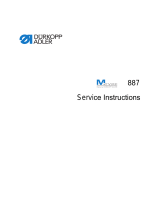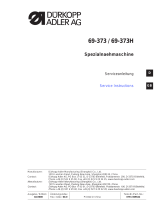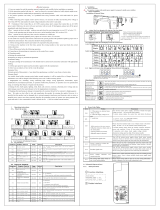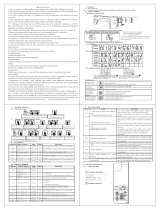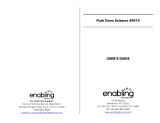Page is loading ...

Anleitung, komplett / Manual, complete
577 - 1111
Postfach 17 03 51, D-33703 Bielefeld • Potsdamer Straße 190, D-33719 Bielefeld
Telefon (05 21) 9 25-0 • Telefax (05 21) 9 25 24 35 Sprache: Deutsch / Englisch
Ausgabe / Edition: 12/00 Printed in Federal Republic of Germany Teile-Nr./Part.-No.: 0791 577001
Inhalt Summary
Bedienanleitung,
Aufstellanleitung,
Serviceanleitung
Bauschaltplan
9890 577001 B
Pneumatik Geräteplan
9770 577001
Instructions for operating
Installing instruction
Instructions for service
Interconnection-diagram
9890 577001 B
Pneumatic circuit plan
9770 577001

577 - 1111
Automatic lockstitch
buttonholer
Instructions for operating
Installing instruction
Instructions for service
Postfach 17 03 51, D-33703 Bielefeld • Potsdamer Straße 190, D-33719 Bielefeld
Telefon (0521) 9 25-0 • Telefax (0521) 9 25 24 35
1
2
3

Foreword
This instruction manual is intended to help the user to become familiar
with the machine and take advantage of its application possibilities in
accordance with the recommendations.
The instruction manual contains important information on how to
operate the machine securely, properly and economically. Observation
of the instructions eliminates danger, reduces costs for repair and
down-times, and increases the reliability and life of the machine.
The instruction manual is intended to complement existing national
accident prevention and environment protection regulations.
The instruction manual must always be available at the
machine/sewing unit.
The instruction manual must be read and applied by any person that is
authorized to work on the machine/sewing unit. This means:
– Operation, including equipping, troubleshooting during the work
cycle, removing of fabric waste,
– Service (maintenance, inspection, repair and/or
– Transport.
The user also has to assure that only authorized personnel work on
the machine.
The user is obliged to check the machine at least once per shift for
apparent damages and to immediatly report any changes (including
the performance in service), which impair the safety.
The user company must ensure that the machine is only operated in
perfect working order.
Never remove or disable any safety devices.
If safety devices need to be removed for equipping, repairing or
maintaining, the safety devices must be
remounted directly after completion of the maintenance and repair
work.
Unauthorized modification of the machine rules out liability of the
manufacturer for damage resulting from this.
Observe all safety and danger recommendations on the machine/unit!
The yellow-and-black striped surfaces designate permanend danger
areas, eg danger of squashing, cutting, shearing or collision.
Besides the recommendations in this instruction manual also observe
the general safety and accident prevention regulations!

General safety instructions
The non-observance of the following safety instructions can cause
bodily injuries or damages to the machine.
1. The machine must only be commissioned in full knowledge of the
instruction book and operated by persons with appropriate
training.
2. Before putting into service also read the safety rules and
instructions of the motor supplier.
3. The machine must be used only for the purpose intended. Use of
the machine without the safety devices is not permitted. Observe
all the relevant safety regulations.
4. When gauge parts are exchanged (e.g. needle, presser foot,
needle plate, feed dog and bobbin) when threading, when the
workplace is left, and during service work, the machine must be
disconnected from the mains by switching off the master switch or
disconnecting the mains plug.
5. Daily servicing work must be carried out only by appropriately
trained persons.
6. Repairs, conversion and special maintenance work must only be
carried out by technicians or persons with appropriate training.
7. For service or repair work on pneumatic systems, disconnect the
machine from the compressed air supply system (max. 7-10 bar).
Before disconnecting, reduce the pressure of the maintenance
unit.
Exceptions to this are only adjustments and functions checks
made by appropriately trained technicians.
8. Work on the electrical equipment must be carried out only by
electricians or appropriately trained persons.
9. Work on parts and systems under electric current is not permitted,
except as specified in regulations DIN VDE 0105.
10. Conversion or changes to the machine must be authorized by us
and made only in adherence to all safety regulations.
11. For repairs, only replacement parts approved by us must be used.
12. Commissioning of the sewing head is prohibited until such time
as the entire sewing unit is found to comply with EC directives.
It is absolutely necessary to respect
the safety instructions marked by these signs.
Danger of bodily injuries !
Please note also the general safety instructions.

Contents Page:
Preface and General Safety Standards
Part 1: Operating Instructions cl. 577-1111
1. Product description . . . . . . . . . . . . . . . . . . . . . . . . . . . . . . . . . . . . . . . . . . . 5
2. Normal use . . . . . . . . . . . . . . . . . . . . . . . . . . . . . . . . . . . . . . . . . . . . . . . . 5
3. Technical data . . . . . . . . . . . . . . . . . . . . . . . . . . . . . . . . . . . . . . . . . . . . . . 6
4. Operation
4.1 Threading the needle . . . . . . . . . . . . . . . . . . . . . . . . . . . . . . . . . . . . . . . . . . . 7
4.2 Winding the hook thread . . . . . . . . . . . . . . . . . . . . . . . . . . . . . . . . . . . . . . . . . 8
4.3 Inserting the bobbin . . . . . . . . . . . . . . . . . . . . . . . . . . . . . . . . . . . . . . . . . . . . 8
4.4 Changing the needle . . . . . . . . . . . . . . . . . . . . . . . . . . . . . . . . . . . . . . . . . . . 10
4.5 Lifting the sewing cage . . . . . . . . . . . . . . . . . . . . . . . . . . . . . . . . . . . . . . . . . . 11
4.6 Regulating the sewing cage pressure . . . . . . . . . . . . . . . . . . . . . . . . . . . . . . . . . . 11
4.7 Setting the buttonhole length . . . . . . . . . . . . . . . . . . . . . . . . . . . . . . . . . . . . . . . 12
4.8 Setting the number of stitches . . . . . . . . . . . . . . . . . . . . . . . . . . . . . . . . . . . . . . 13
4.9 Changing and adjusting the knife (slot cutting) . . . . . . . . . . . . . . . . . . . . . . . . . . . . . 14
4.10 Changing and adjusting the knife (plastic cutting) . . . . . . . . . . . . . . . . . . . . . . . . . . . 16
4.11 Exchange the plastic cutting plate (only in case of plastic cutting) . . . . . . . . . . . . . . . . . . 17
4.12 Thread tension . . . . . . . . . . . . . . . . . . . . . . . . . . . . . . . . . . . . . . . . . . . . . . . 18
5. Control and control panel
5.1 General . . . . . . . . . . . . . . . . . . . . . . . . . . . . . . . . . . . . . . . . . . . . . . . . . . . 19
5.2 Keys on the control panel . . . . . . . . . . . . . . . . . . . . . . . . . . . . . . . . . . . . . . . . . 20
5.3 Changing parameter values . . . . . . . . . . . . . . . . . . . . . . . . . . . . . . . . . . . . . . . 21
6. Sewing
6.1 Normal sewing cycle . . . . . . . . . . . . . . . . . . . . . . . . . . . . . . . . . . . . . . . . . . . 24
6.2 Interruption of the sewing cycle . . . . . . . . . . . . . . . . . . . . . . . . . . . . . . . . . . . . . 24
6.3 Monitoring the hook thread by counting the buttonholes . . . . . . . . . . . . . . . . . . . . . . . . 25
7. Maintenance
7.1 Cleaning and checking . . . . . . . . . . . . . . . . . . . . . . . . . . . . . . . . . . . . . . . . . . 26
7.2 Lubrication . . . . . . . . . . . . . . . . . . . . . . . . . . . . . . . . . . . . . . . . . . . . . . . . . 27
8. Auxiliary equipment . . . . . . . . . . . . . . . . . . . . . . . . . . . . . . . . . . . . . . . . . . . 28
1
3

Stand set for longitudinal installation
Stand set for transversal installation
Stand set for transversal/longitudinal operation
4

1. Product description
The DÜRKOPP ADLER 577-1111 is an automatic double lockstitch
machine with bottom and top feed for sewing buttonholes with two
straight bars.
Normal sewing mode:
During the sewing process the fabric face (the face seen) is up.
The machine can be supplied in three installation variants (see on the
left).
2. Normal use
The automatic sewing machine DÜRKOPP ADLER 577-1111 has been
designed for sewing light to middle-heavy weight material, as used in
the apparel industry.
Such material consists generally of textile or synthetic fibres.
Furthermore, the machine lends itself for producing so-called technical
seams. In this case, the user must estimate any possible dangers
(contact Dürkopp Adler AG for help), Technical seams are seldom, but
they may be very versatile. Proper safety precautions, depending on
the result of such an estimation, must be taken. Generally, only dry
material should be sewn on this machine. And the material should not
exceeded the thickness of 4 mm when compressed by the lowered
sewing foot.
The material should not contain any hard objects, because otherwise it
would be necessary to protect the eyes during the sewing process..
For the time being, no such eye guard is available. The seams are
produced generally with threads up to 65/2 Nm (cotton-covered
synthetic threads or synthetic threads). Before using any other threads
it is necessary, also in this case, to estimate the consequential
dangers and to take, if necessary, the respective safety measures.
This automatic sewing unit should be installed and operated only in
dry and proper rooms. Otherwise, further precautions (to convene)
may be needed, (see EN 60204-31:1999). We, manufacturers of
industrial sewing machines, assume, that our machines will be
operated at least by a well trained staff, knowing all usual controls and
any possible dangers.
1
5

3. Technical data
Machine heads: Class 577-1111
Needle system: System 265, needle point slightly rounded off
Needle thickness: 70 - 100, Standard 80
Threads: Synthetic threads, and cotton-coated
synthetic threads
Up to 65/2 Nm
Stitch type: Double lockstitch
Speed: up to. 4000 rpm ( adjustable )
Number of stitches
Per seam pattern: 76 - 510
Buttonhole length: 10 - 48 mm
Buttonhole width: 0 - 6 mm
Cut length: max. 38 mm
Motor type: EFKA DC1600/DA82GL
Nominal performance: 0,75 kW
Speed: 4000 U/min
Service pressure: 6 bar
Air consumption: about 4 NL per working cycle
Nominal voltage: 1 ~ 230 V, 50/60 Hz
1~ 190 - 240 V, 50/60 Hz
Dimensions:
Longitudinal stand: 1060 x 620 x 1250 mm ( L x B x H )
Longitudinal/transversal
stand: 800 x 650 x 1250 mm ( L x B x H )
(Machine head without stand: 180 x 600 x 450)
Working level: 750...895 mm ( Table top )
Weight: ca. 135 kg ( with stand )
Rated noise level: Lc = 80 dB (A)
6

4. Operation
4.1 Threading the needle
CAUTION: DANGER OF ACCIDENTS !
Turn off main switch!
Switch off the machine before threading the needle.
–
Thread then needle according to the illustration.
1
7

4.2 Winding the hook thread
–
Slip the reel onto its stand.
–
Thread the hook according to the illustration.
–
Slip the bobbin onto the bobbin winder 1 .
–
Wind the hook thread clockwise about 5 times around the bobbin
core.
–
Swing bobbin winder lever 2 towards the bobbin and let it snap.
–
The thread will be wound during the sewing process.
–
The bobbin winder lever 2 will stop the winding process as soon as
the bobbin is full.
–
Following the winding process, tear off the bobbin thread at the
thread clamp 3.
4.3 Inserting the bobbin
CAUTION: DANGER OF ACCIDENTS !
Turn off main switch!
Switch off the machine before changing the bobbin!
Removing empty bobbin.
–
Open hook space cover 4.
–
Lift the bow 5 and remove bobbin case top together with the
bobbin.
–
Remove the empty bobbin from the bobbin case top.
3
1
2
8

Threading the bobbin
–
Insert the full bobbin into the bobbin case top. When unwinding the
thread, the bobbin must turn counter clockwise.
–
Pass the hook thread through the slit 6 and under the spring 7.
–
Depending on the buttonhole to be sewn, pass the hook thread
through the slit 9 for a raised buttonhole (more thread will be
advanced across the hook back) or through the slit 10 for a flat
buttonhole (less thread).
–
Cut then the thread, passed as described, by the knife 11.
Adjusting the hook thread tension
–
Adjust the hook thread tension by turning the screw 12 so that,
when holding the thread at its end, the bobbin case descends by
its own weight.
Inserting the bobbin case top
–
Place the bobbin case top together with the bobbin onto the bobbin
case bottom and ensure that the bow 5 snaps (what you should
hear).
–
Close the hook space cover 4.
5
4
11
6
12
7
9
10
1
9

4.4 Changing the needle
CAUTION: DANGER OF ACCIDENTS !
Turn off main switch!
Switch off the machine before changing the needle!
Knife side
–
Loosen the screw 1.
–
Remove the neelde from its bar.
–
Introduce the new needle as deep as possible into its bar a.
–
Adjust the needle so that its furrow is located on the other side of
the knife.
–
Tighten the screw 1.
NOTE !
The factory-set distance between the hook and the needle applies to
the needles having a thickness of 80.
When inserting a needle having a different thickness it may be
necessary to correct the distance (see the Service Instructions).
1
10

4.5 Lifting the sewing cage
The sewing cage 2 will be lifted only if the main switch is turned on
and if following conditions exist:
–
Sewing cage in initial position (rear position)
–
Thread take-up lever in top dead-center position (needle in upper
position)
If the thread take-up lever does not stand in its top dead-center
position (error message in the display of the control panel: "_001 0"),
the machine will automatically turn into this position after turning on
the main switch.
After turning on the main switch, following message will be presented
on the display of the control panel: "_0001". if the sewing cage does
not stand in its initial position Turn then the crank until the sewing
cage stands in the proper position and can be lifted. By treading the
pedal forwards into its 1
st
position, the sewing cage will be lowered
without starting the sewing process.
The sewing cage can be lifted and lowered by the key 3 on the control
panel. Then it is necessary to switch on the parameter "F - 020" on
the operator level (see chapter 4.9).
4.6 Regulating the sewing cage pressure
–
The sewing cage pressure can be regulated by the screw 3.
3
2
1
11

4.7 Setting the buttonhole length
CAUTION: DANGER OF ACCIDENTS !
Turn off main switch!
Turn off the machine before changing the buttonhole length!
–
Remove the crank 1.
–
Open the cover 2 completely.
–
Loosen the screw 3.
–
Reset the lever 4 in the crank.
–
Tighten the screw 3.
–
Release the support 5 and close the cover 2.
–
Install the crank 1.
5
3
4
2
1
12

4.8 Setting the number of stitches
CAUTION: DANGER OF ACCIDENTS !
Turn off main switch!
Switch of the machine before changing the number of stitches!
–
Remove the crank.
–
Open the cover 2.completely
–
Change the gears 6 in pairs according to the table.
–
Release the support 5 and close the cover.
–
Install the crank.
Number of
stitches
202
212
223
235
247
261
274
289
305
321
339
358
379
401
425
451
479
510
Number of
teeth
at top / at bottom
40 / 39
41 / 38
42 / 37
43 / 36
44 / 35
45 / 34
46 / 33
47 / 32
48 / 31
49 / 30
50 / 29
51 / 28
52 / 27
53 / 26
54 / 25
55 / 24
56 / 23
57 / 22
Number of
teeth
at top/at bottom
22 / 57
23 / 56
24 / 55
25 / 54
26 / 53
27 / 52
28 / 51
29 / 50
30 / 49
31 / 48
32 / 47
33 / 46
34 / 45
35 / 44
36 / 43
37 / 42
38 / 41
39 / 40
Number of
stitches
76
81
86
91
97
102
108
114
120
127
134
141
149
157
165
173
182
192
2
6
5
1
13

4.9 Changing and adjusting the knife (slot cutting)
CAUTION: DANGER OF ACCIDENTS !
Turn off main switch!
The sewing cage must stand in its initial position, because otherwise
the knife will knock against the cage!
Switch on the adjustment aid before installing the knife!
Remove the knife
–
Loosen the nut 1.
–
Pull out the knife 2.
Install the knife
Switch on the adjustment aid, and:
–
Turn on the main switch.
(the cage will be lifted.)
–
Press the key "P" on the control panel.
(The menu of the operator level will be called up.)
–
Cross the menu by operating the key until "+" "F - 020" is
displayed.
–
"oFF" will appear after pressing the key "E".
–
Press the key "+" for switching on the adjustment aid.
(The display will present "on" and an arrow above the key 3.)
NOTE !
Do not turn the handwheel or the crank when using the adjustment aid!
3
1
2
14

–
Insert new knife (loosen nut 1) and push it first up to the top.
NOTE !
It is absolutely necessary to note that the distance between the needle
thread scissors and the knife bottom amounts to at least. 1 mm.
–
Tighten the nut 1.
–
Lower the sewing cage by pressing the key Taste 3.
–
With the adjustment aid still being engaged, it is now possible to
lower the knife block by operating the key 4.
(An arrow will appear above the key 4.)
–
Operate the key 4 once again for lifting the knife block.
The knife block cannot be moved down by the key 4 as long as the
sewing cage is not lowered. Therefore, first lower the sewing cage by
the key 3. Also the function of the key 3 (lifting the sewing cage) is
locked as long as the knife is in its lower position.
It will be impossible to start the machine as long as the adjustment aid
is engaged.
Adjusting the knife
When the knife block is lowered, the front edge of the knife should
stand about 2 mm under the bottom of the throat plate.
Adjustment:
–
Lift the sewing cage.
–
Loosen slightly the nut 1.
–
Displace the knife.
–
Tighten the nut 1.
–
Check the cutting depth and repeat the process, if required.
The cut of the knife should be about 2 tissue threads from the last
sewn final bartack.
Adjustment:
–
Loosen the screw 3 and adjust the distance accordingly.
Note:
When the knife block is in its lowered position, the safety distance
between the front edge of the knife and the slit in the throat plate
insert must amount to 0,5 mm.
–
Tighten the screw 3.
End the adjustment aid
For ending the adjustment aid press the key "P" on the control panel.
1 2 3 4 A B
1
15

4.10 Changing and adjusting the knife (plastic cutting)
CAUTION: DANGER OF ACCIDENTS !
Turn off main switch!
The sewing cage must stand in its initial position, because otherwise
the knife will knock against the cage!
Switch on the adjustment aid before installing the knife!
Remove the knife
–
Loosen the nut 1.
–
Pull out the knife 2.
Install the knife
Turn-in the cutter depth stop completely and turn on the adjustment
aid, and:
–
Turn on the main switch.
( the cage will be lifted. )
–
Press the key "P" on the control panel.
(The menu of the operator level will be called up.)
–
Cross the menu by operating the key until "+" "F - 020" is
displayed.
–
"oFF" will appear after pressing the key "E".
–
Press the key "+" for switching on the adjustment aid.
(The display will present "on" and an arrow above the key 3.)
NOTE !
Do not turn the handwheel or the crank when using the adjustment aid!
3
1
2
45 4
16

–
Insert new knife (loosen nut 1) and push it first up to the top.
NOTE !
It is absolutely necessary to note that the distance between the needle
thread scissors and the knife bottom amounts to at least. 1 mm.
–
Tighten the nut 1.
–
Lower the sewing cage by pressing the key Taste 3.
–
With the adjustment aid still being engaged, it is now possible to
lower the knife block by operating the key 4.
(An arrow will appear above the key 4.)
Set the cutter for the cutting position.
When the cutter block is lowered and the cutter depth stop. Is fully
turned in, the cutter should rest on the plastic cutting block.
Adjustment:
–
Lower cutter block.
–
Loosen slightly nut 1
–
Press the cutter against the cutting block
–
Tighten nut 1
–
Make sewing test and check the cutting result. If required, correct
the cutting depth by the cutter stop.
The cut of the knife should be about 2 tissue threads from the last
sewn final bartack.
Adjustment:
–
Loosen the screw 3 and adjust the distance accordingly.
Note:
When the knife block is in its lowered position, the safety distance
between the front edge of the knife and the slit in the throat plate
insert must amount to 0,5 mm.
–
Tighten the screw 3.
End the adjustment aid
For ending the adjustment aid press the key "P" on the control panel.
4.11 Exchange the plastic cutting plate (only in case of plastic cutting)
–
Loosen the screws 4
–
Lift off the cutting plate 5 by a screwdriver and remove.
–
Insert new cutting plate, press against the counter holder and
tighten the screws 4
–
Adjust according to chapter 4.10 Changing and setting the
cutter (plastic cutting).
1 2 3 4 A B
1
17

4.12 Thread tension
The machine head has been set in the factory for sewing buttonholes
with flat bartacks and with raised lips.
Pre-tension
The pre-tension 4 is always active. It serves for stabilising the needle
thread. It should be set to the minimum value (5-10 g). The
pre-tension 4 has scarcely any influence on the seam pattern.
Main tension
The main tension 5 is active when sewing both buttonhole lips. But the
main tension 5 it is out of action when bartacking and when cutting the
threads.
Bartack tension
The bartack tension 6 is opened only when cutting the threads. It is
remains closed during the entire remaining sewing process.
Buttonhole lip tension
The buttonhole lip tension is produced jointly by the main tension 5
and by the bartacking tension 6. About 1/3 of the buttonhole lip tension
should be produced by the bartacking tension 6.
Adjustment
–
Thread the needle thread so that it does not pass through the main
tension 5.
–
Start the sewing process.
4
5
6
18
/





